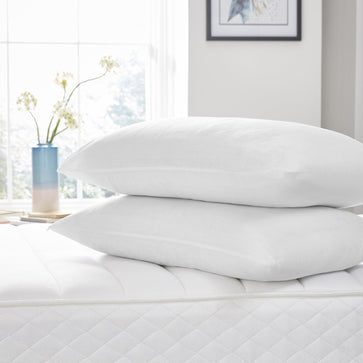How Many Pillows Should You Sleep With?



How Many Pillows Should You Sleep With Neck Pain?
If you suffer from neck pain, the number of pillows you use can greatly impact your comfort. Generally, one supportive pillow that conforms to the natural curve of your neck is recommended. Memory foam or cervical pillows are excellent choices as they provide tailored support. Avoid using too many pillows, as they can elevate your head too much, leading to further strain on your neck.
15% OFF
GET FLAT 15% OFF ON YOUR FIRST PURCHASE

How Many Pillows Should You Sleep With Under Your Head?
The number of pillows under your head largely depends on your sleeping position and personal comfort. For most people, one pillow is sufficient. It should be supportive enough to keep your head, neck, and spine neutral. However, if you have broader shoulders, you might need a thicker pillow or an additional one to achieve the same level of comfort and alignment.
How Many Pillows Back Sleepers Should Use?
The optimal number of pillows for back sleepers is typically one under the head. The primary goal for back sleepers is to maintain the natural curvature of the spine, which extends from the lower back up through the neck. Using one well-chosen pillow can help achieve this by providing the necessary support without causing the head to tilt too far forward or backwards.

The ideal pillow for back sleepers is often medium-firm and designed to cradle the head while supporting the neck. Memory foam or contoured pillows are particularly effective because they conform to the shape of the head and neck, ensuring proper alignment throughout the night.
In addition to the primary pillow under the head, some back sleepers benefit from placing a small pillow under their knees.
This additional support can reduce strain on the lower back by promoting a natural curve in the spine. A knee pillow helps alleviate pressure on the lumbar region by slightly elevating the knees, which can be particularly beneficial for individuals who suffer from lower back pain.
Choosing the right pillow height is also crucial for back sleepers. A pillow that is too high can push the head forward, creating an unnatural angle that can lead to neck pain. Conversely, a pillow that is too flat can cause the head to tilt backwards, resulting in discomfort. Therefore, a balance must be struck, often best achieved with a single, supportive pillow under the head.
In short, back sleepers should use one supportive pillow under the head, complemented by a small pillow under the knees if additional lower back support is needed. This combination helps maintain proper spinal alignment, reduces strain, and promotes rest and pain-free sleep.
How Many Pillows Side Sleepers Should Use?
For side sleepers, achieving optimal comfort and spinal alignment often requires using more than one pillow. The primary goal is to ensure that the head, neck, and spine remain neutral throughout the night, preventing discomfort and promoting restful sleep. Generally, side sleepers should use two pillows: one for the head and one to place between the knees.
The pillow used for the head should be firm and thick enough to fill the gap between the ear and shoulder, maintaining the natural alignment of the neck with the spine. A pillow that is too thin can cause the head to tilt downward, leading to neck strain and pain.
Conversely, a too-thick pillow can push the head upward, causing misalignment and discomfort. Memory foam pillows, or those specifically designed for side sleepers, are often ideal because they contour to the shape of the head and neck, providing consistent support.
In addition to the head pillow, placing a second pillow between the knees can significantly enhance comfort and alignment for side sleepers. This practice helps keep the hips, pelvis, and spine in proper alignment, reducing pressure on the lower back and preventing the upper leg from pulling the spine out of its neutral position.
The knee pillow should be firm enough to maintain its shape throughout the night but soft enough to provide comfort. A body pillow can also effectively serve this purpose, offering upper and lower body support.
Furthermore, some side sleepers might benefit from using additional pillows to support other body parts. For instance, a small pillow can be placed under the waist to prevent the lower back from sagging, or a thin pillow can support the arm resting on the bed to alleviate shoulder strain.
These additional pillows are especially useful for individuals with specific pain points or requiring extra support to maintain a comfortable sleeping posture.
Overall, while two pillows are generally recommended for side sleepers—one for the head and one for between the knees—individual preferences and needs may vary. The key is to find a combination that provides adequate support and maintains the spine's natural alignment. By doing so, side sleepers can significantly improve their sleep quality, wake up refreshed, and reduce the risk of developing chronic pain related to poor sleeping posture.
How Many Pillows Stomach Sleepers Should Use?
Stomach sleeping is generally not recommended because it can strain the neck and back. However, if you prefer this position, using a very thin pillow or no pillow under your head can help reduce the strain on your neck. Some stomach sleepers also find placing a pillow under their pelvis comfortable to maintain a more neutral spine alignment.
How Many Pillows for Acid Reflux?
An easy way to alleviate acid reflux is to prop up your upper body so that acid doesn't go up your throat. Using two or more pillows to prop up your head and upper body can be effective. Alternatively, a wedge pillow for acid reflux can provide a more stable and comfortable incline.
How Many Pillows for Sleep Apnea?
For those with sleep apnea, the goal is to keep the airways open during sleep. Elevating the head slightly can help, but using too many pillows can cause the head to tilt forward, potentially worsening the condition. One or two pillows offering firm support and aligning the head and neck are usually recommended. Specialised pillows for sleep apnea, such as CPAP, can also be beneficial.

Conclusion
The right number of pillows can significantly enhance sleep quality and overall health. While the general guideline is to use one supportive pillow under your head, individual needs can vary based on your sleeping position and any specific health concerns you might have. Side sleepers may need additional pillows for knee support, while those with conditions like acid reflux or sleep apnea might require specialised solutions. By paying attention to your body's needs and adjusting your pillow use accordingly, you can achieve better sleep and wake up refreshed and pain-free.
FAQs
How often should you replace your pillows?
Pillows should generally be replaced every 1 to 2 years. Over time, pillows lose shape and support, affecting your sleep quality and neck alignment. Signs that it's time to replace your pillow include visible lumps, flattened areas, and lingering odours despite regular washing.
Can sleeping with too many pillows be harmful?
Yes, sleeping with too many pillows can be harmful. Excessive elevation can cause misalignment of the head, neck, and spine, leading to discomfort and pain. Using the right number of pillows to maintain proper alignment and support based on your sleeping position is essential.
What is the best pillow for people with allergies?
Hypoallergenic pillows are the best choice for people with allergies. These pillows are made from materials that resist dust mites, mould, and other allergens. Memory foam, latex, and pillows with synthetic fills like polyester are good options. Additionally, using pillow protectors can help keep allergens at bay.
How can you tell if your pillow is causing neck pain?
If you wake up with neck pain that improves throughout the day, your pillow might be the culprit. Other signs include frequent tossing and turning at night, headaches, and noticing that your pillow has lost its shape or support. Switching to a pillow with better alignment and support can help alleviate these issues.
Are there benefits to sleeping without a pillow?
Sleeping without a pillow can benefit certain sleeping positions, particularly for stomach sleepers, as it can help keep the spine in a more neutral position. However, using a pillow is generally better for back and side sleepers to maintain proper alignment and prevent neck and back pain.





